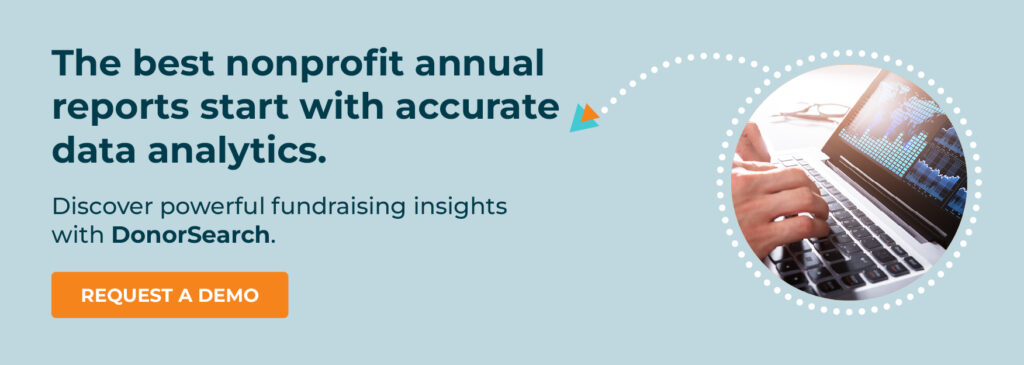
How to Create a Standout Nonprofit Annual Report + Template
For nonprofits like yours, a thoughtfully written and well-designed annual report can be an invaluable fundraising tool. It can be used to cultivate new relationships with donors, sponsors, volunteers, and other community members. Plus, it helps recognize and retain those who have helped you make progress toward your goals over the past year.
With so much at stake, it’s critical to take the creation of your annual report seriously and seek guidance on how to make it a useful resource for your organization’s community. To help you get started, this guide will cover all you need to know about nonprofit annual reports, including:
- What is a nonprofit annual report?
- Nonprofit Annual Report Template & Elements to Include
- Choosing a Format for Your Annual Report
- Nonprofit Annual Report Best Practices
- Our Favorite Nonprofit Annual Report Examples
These tips and strategies will put you well on your way to creating a digestible, engaging annual report that inspires your audience to continue supporting your organization’s work. Let’s dive in!

What is a nonprofit annual report?
An annual report is a document designed to highlight your nonprofit’s major accomplishments, build confidence in your organization, inspire readers to support your mission, and thank the donors and volunteers who make your work possible.
Nonprofits typically compile and release these reports every year, although they aren’t always mandatory. On a national level, the only document you’re required to file to maintain your organization’s 501(c)(3) status is an annual tax return via IRS Form 990. However, some state governments request a copy of nonprofits’ annual reports to maintain their charitable solicitation registration in that state, so make sure to stay up-to-date on your state’s filing requirements.
Benefits of Creating an Annual Report
Even if your nonprofit isn’t required to file its annual report with your state, there are advantages to compiling one. For most nonprofits, the ultimate goal—and the ultimate benefit—of their annual report is simple: retaining current supporters and acquiring new ones.
To accomplish this goal, your annual report must fulfill several smaller purposes, each of which benefits your organization’s long-term health:
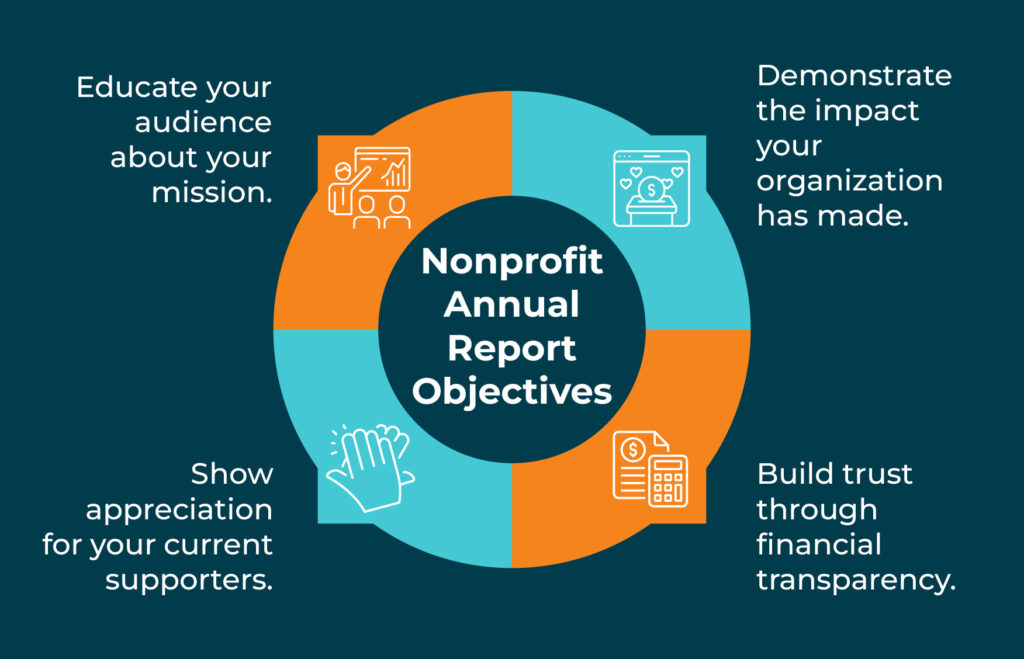
- Educate your audience about your mission.
- Demonstrate the impact your organization has made.
- Build trust through financial transparency.
- Show appreciation for your current supporters.
Additionally, although annual reports reflect on the past year, they can also establish a framework for your nonprofit to move forward and achieve more in the year to come!
Annual Reports & Prospect Research
It’s common for nonprofits to include the names of their major donors and the projects they contributed to somewhere in their annual reports. This information can help feed charitable giving databases that you can use for prospect research. DonorSearch, for example, culls hundreds of annual reports to collect data on major donors’ giving history.
While your annual report can cultivate better relationships with existing donors and encourage others to support your cause, you can also use the information from other nonprofit reports to fuel your prospect research. Prospect research professionals can find a wealth of ideal prospects for your nonprofit just by looking at the annual reports of similar organizations.
Let’s say that your nonprofit works to reduce food insecurity for children in your area. If a local hospital highlighted a major donor in their annual report who contributed to the hospital’s pediatric intensive care unit, your organization might want to target that person as a potential major donor, since you can infer that they’re likely interested in helping children.

Nonprofit Annual Report Template & Elements to Include
If you’re creating your nonprofit’s first-ever annual report or looking to switch up your format, it can be useful to work off of a template. The template below is a representation of a page of your annual report or a shortened digital version you can deliver via email. The use of graphics and images provides a suggestion for how to effectively divide up the space and produce a more visually appealing layout:
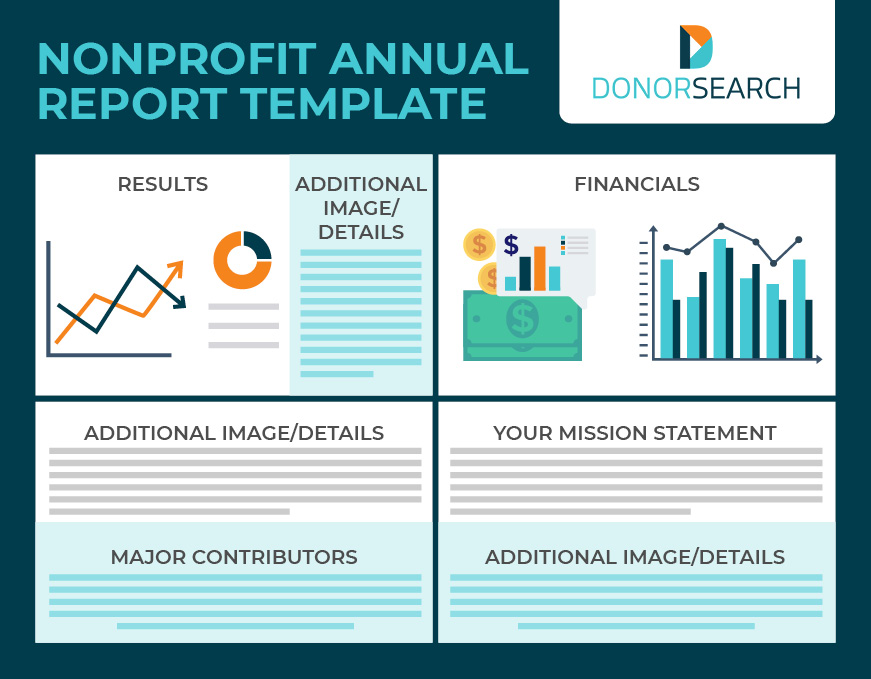
This template includes the four most essential elements of a nonprofit annual report, which we’ll discuss in more detail in the following sections.
1. Clear Mission Statement
Dedicated, long-time supporters and individuals who are brand new to your organization’s community will both read your annual report. Each of these groups of readers should be confident in their understanding of your organization’s mission before diving into the data, which is why you should write out your mission statement at the beginning of the report.
Keep your mission statement to one or two sentences to help it stick in readers’ minds, and ensure it includes the most important details about why your organization does what it does every day. One nonprofit that does this particularly well is the American Red Cross, whose mission statement reads, “The American Red Cross prevents and alleviates human suffering in the face of emergencies by mobilizing the power of volunteers and the generosity of donors.”
You can also include your vision statement alongside your mission statement. Your vision statement is a sentence that describes the future state your nonprofit is working toward—i.e., what you hope the world will look like when your mission is accomplished.
2. Major Achievements From the Past Year
The majority of your annual report should focus on the activities and projects your organization completed over the past year, from hosting fundraising events to coordinating volunteer efforts to delivering services in your community. Reflect on your organization’s audience and what would be most interesting to them, but make sure to share your biggest accomplishments!
First, use your fundraising tools to break down your achievements into statistics your readers can easily understand. You might report the total amount your donors gave, the number of hours your volunteers worked, or how many social media followers you gained. Then, format that data using graphs and visualizations to make it easier for readers to understand, and supplement the numbers with photos and true stories about your work to further emphasize your impact.
3. Financial Information
It’s no secret that your donors want to know how your nonprofit is using their money to further your mission. Being honest and transparent about your spending and fundraising builds trust with your existing supporters. Plus, it shows potential donors that your nonprofit can manage funds responsibly and effectively, which can make them more likely to give.
However, some high-impact donors who are very financially literate will want to see detailed records of your nonprofit’s financial status, while others would prefer an easy-to-follow, summarized version of the data. To accommodate both of these preferences, include graphical representations of key financial information in the body of your annual report, then attach detailed financial statements as appendices for donors who want to learn more.
4. List of Major Contributions
In addition to showcasing your nonprofit’s success, your annual report is also about thanking those who helped you achieve those goals. The best way to do this is by listing out and thanking your major donors, board members, and organizational leadership.
Additionally, include a general statement of thanks to your volunteers and donors at all levels. Although you should have a more personalized thank-you cadence for each supporter when they contribute, a general shoutout will make them feel appreciated and seen by your organization!
Choosing a Format for Your Annual Report
Once you add each of the elements listed above to your annual report, you’ll need to decide how to present the information to your nonprofit’s community. While most organizations publicize their annual reports on a dedicated page of their websites, how you further publicize it will depend on your audience’s preferences.
A combination of hard-copy and digital annual report materials will generally reach the widest audience. Here are some popular formats in each category to consider:
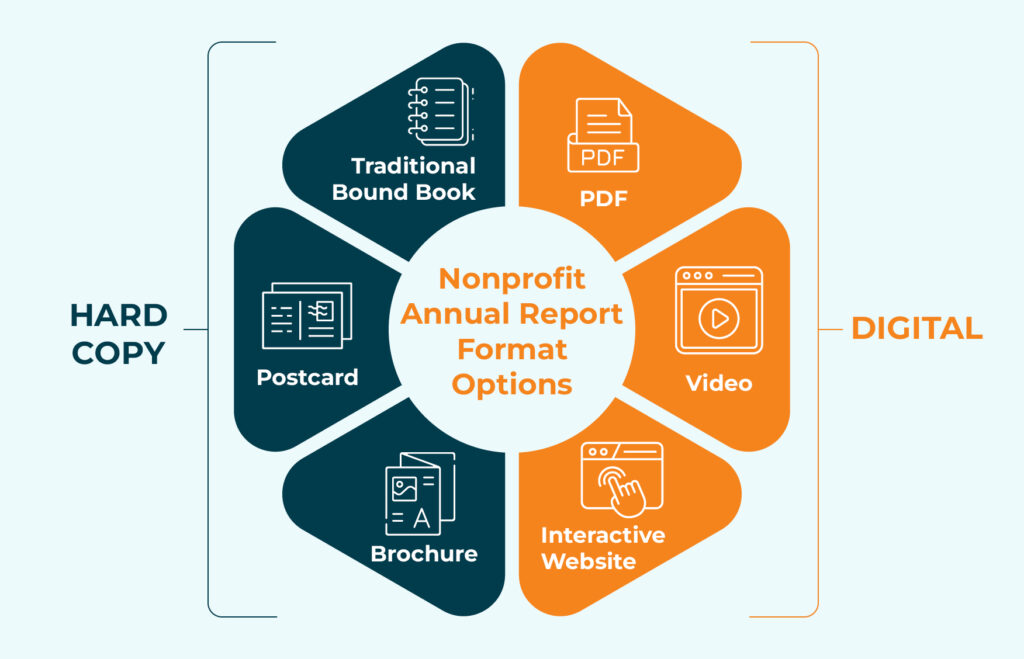
Hard Copy Annual Reports
- Traditional bound book: These can be anywhere from a few to 100 pages long and are great for compiling a large amount of information in a substantial, tangible way. No matter how long your report is, make sure to keep the content engaging and break up the text with plenty of visuals.
- Postcard: If you’d like to maximize digestibility, postcards are a good choice. With well-designed infographics, pictures, and statistics, supporters can very quickly understand how your organization did last year. Because of space limitations, you’ll have to sacrifice some copy, so if you want to tell detailed stories or include a long list of donors, choose a longer-form option.
- Brochure: Still considered a quick read, brochures are a middle ground between a postcard and a book. The folds in a brochure create natural divides to easily section your information and design.
Digital Annual Reports
- PDF: If you want the space that a book offers but don’t want to spend the money or use tons of paper to print it, PDFs are a good solution. You can make them as long or short as you like, embed other digital content like links, videos, and PowerPoint presentations, and easily upload them to your website or attach them to an email.
- Video: Video annual reports show, rather than tell, your audience what your organization has accomplished. Make sure your final video comes across as professional in its editing and production, and recruit outside help if necessary.
- Interactive website: Consider building a webpage or mini-site that houses an interactive version of your annual report. Your audience could click through a photo gallery, expand graphs for a more detailed view, and play multiple short videos, making for an immersive experience.
If you use multiple formats, think about who the primary audience is for each type. Newer, lower-level supporters will likely be happy with condensed versions of your annual report like videos or postcards, while important stakeholders will want to see more comprehensive information in a book or PDF.
Nonprofit Annual Report Best Practices
Now that you know what to include in your annual report and your options for formatting it, you’re likely ready to dive into creating your own. As you compile the report, keep these six best practices in mind.
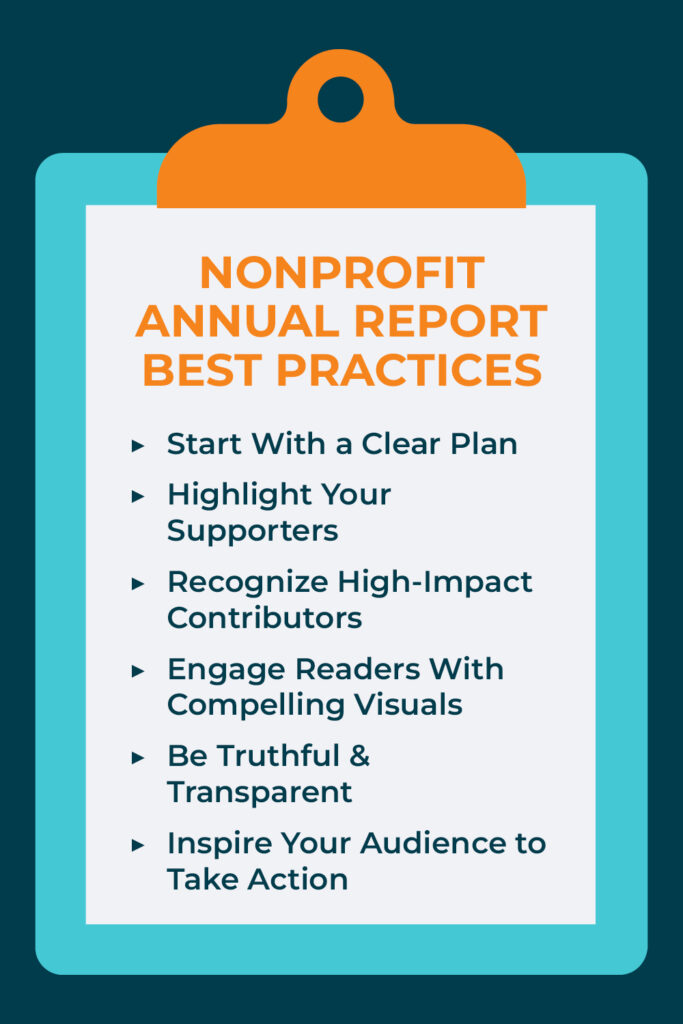
1. Start With a Clear Plan
The first step for every successful project at your nonprofit is creating a plan, and your annual report is no exception. You’ll likely need the help of multiple team members or departments to assemble all of the information, as well as compile and design the document.
First, determine your report’s audience. This will likely include your current supporters as well as prospective donors, corporate sponsors, and grantmaking foundations. If you have to file your annual report with your state government, they’re also part of your audience.
Then, consider your purpose and strategy. At its core, your annual report should persuade your audience to support your cause. However, you might have smaller objectives, such as highlighting a new project or attracting more local sponsors, that align with your nonprofit’s strategic plan. Because it’s difficult to cover everything your organization has done in a year in a single document, focus your report on three to five core themes that point readers back to your objectives.
Finally, turn to the action aspect of your plan. This part of your strategy may include:
- Delegating responsibilities and creating timelines for team members.
- Interviewing supporters, leaders, and beneficiaries.
- Compiling and formatting financial data.
- Collecting key metrics from fundraising campaigns.
When your nonprofit has a clear plan, the process of creating your report will go more smoothly, and the end result will be more impactful.
2. Highlight Your Supporters
As we’ve mentioned before, your annual report is a chance to showcase the good your nonprofit has done. That being said, it’s easy for nonprofits to simply celebrate their accomplishments and forget to mention the support that made them possible.
Rather than focusing solely on your achievements, highlight how different projects and programs were realized because of your supporters’ contributions. Every form of support your organization received was essential to your success, so thank them for their monetary gifts, in-kind donations, volunteer time, event participation, advocacy for your cause, and more.
By showing donors and volunteers that your accomplishments were possible because of their support, they’ll know that you’re aware of everything they do. Plus, it demonstrates to potential donors that your nonprofit is built on the support of passionate people and encourages them to join that community.
3. Recognize High-Impact Contributors
In addition to discussing your supporters’ accomplishments generally, set aside space in your annual report to draw extra attention to the supporters who went above and beyond for your cause. Besides the customary list of major donors and the initiatives they supported, consider including stories about some of these donors or other individuals who have been especially impactful to your cause, such as a loyal volunteer or a long-serving board member.
High-impact supporters like this deserve much more recognition than a simple, generic thank-you message, and your annual report is a great place to publicly show your gratitude. When donors feel appreciated and valued in this way, they’re more likely to continue engaging with your nonprofit long-term.
4. Engage Readers With Compelling Visuals
Compiling all of your efforts and data from the past year and condensing them into a single document provides a lot of information for current and prospective supporters to read! This is where strategically placed visuals come in.
Along with capturing and keeping readers’ attention, annual report visuals have many benefits, such as:
- Breaking up blocks of text to make the report more skimmable.
- Transforming complex data into easy-to-understand graphs.
- Translating your mission statement into a tangible need that your audience can develop a passion for.
Incorporate a combination of graphical data visualizations and relevant photos into your report, and make sure to get subjects’ consent if the pictures include any people. For online reports, make some of your visuals interactive for increased engagement.
5. Be Truthful & Transparent
While your annual report is primarily about highlighting your success, it’s important to be honest about your organization’s progress. Sometimes your projects won’t go as planned—and that’s okay!
By briefly mentioning your missteps and how you plan to correct the issue in the future, you’ll show your audience that you’re proactive in solving problems. Make sure to address:
- The causes of your setbacks (if you know what they are).
- The changes you plan to make in the future based on the information you currently have.
- How you’ll gather and incorporate feedback from your supporters as you address these issues.
Touching on setbacks will paint a full picture of the previous year’s progress and demonstrate to donors that despite your challenges, you were still able to make significant strides in furthering your mission.
6. Inspire Your Audience to Take Action
Once you’ve effectively conveyed your mission and achievements in your annual report, many readers might be wondering, “What’s next?”
Dedicate space in your annual report to let readers know how they can support your cause. At minimum, include a link or QR code to your online donation page depending on what format you choose. You might also direct readers to other ways they can get involved, such as:
- Signing up to volunteer
- Registering for the first fundraising event of the new year
- Taking advantage of corporate philanthropy programs like employer matching gifts or volunteer grants
Additionally, mention other places where readers can learn more. Include your organization’s website URL, phone number, mailing and email addresses, and social media handles so your audience can stay in touch with you.
Our Favorite Nonprofit Annual Report Examples
To show you these strategies in practice, we’ve compiled a list of our top five nonprofit annual reports. If you still aren’t sure where to start with creating your organization’s annual report, these examples might just spark some inspiration!
The Nature Conservancy
The Nature Conservancy (TNC) describes itself as “a global environmental nonprofit working to create a world where people and nature can thrive.” For their 2022 annual report, they chose two eco-friendly formats: an interactive website and a PDF that their international community of readers can download in English, Spanish, or Mandarin.
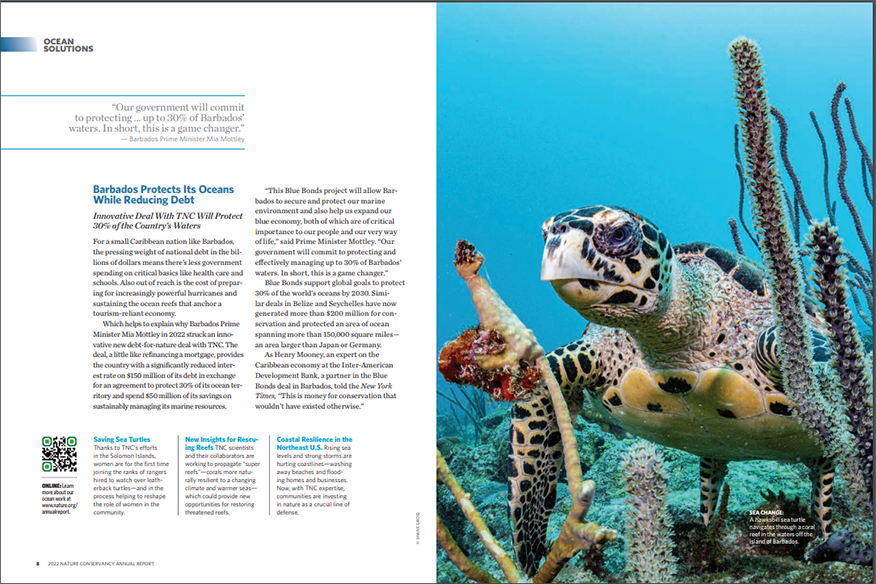
Some highlights of TNC’s report include:
- A concise explanation of their “2030 Goals” strategic plan with accompanying graphics.
- Articles on each of their key projects that highlight their donors and partners, along with relevant photos and opportunities to learn more.
- Multiple formats for their financial data, including a summary bar graph, a letter from the CFO, and a detailed accounting report.
Read The Nature Conservancy’s full annual report.
National FFA Organization
The National FFA Organization (FFA stands for Future Farmers of America) is “the premier youth organization preparing members for leadership and careers in the science, business and technology of agriculture.” FFA compiles a digital annual report that can be viewed as a downloadable PDF or on a dedicated mini-site.

Some highlights of FFA’s 2022 annual report include:
- An organized three-part structure based on the pillars of the nonprofit’s 2022-2025 strategic plan: Evolve, Engage, and Empower.
- A timeline highlighting the most important activity or achievement of each month.
- Branded graphics that compile and summarize statistics about all of the nearly 9,000 local FFA chapters.
Read the National FFA Organization’s full annual report.
World Vision International
World Vision International (WVI) is a faith-based nonprofit organization that works to respond to poverty, provide emergency relief, and promote social justice around the world. Its eye-catching 2022 annual report is available as a downloadable PDF on their website.
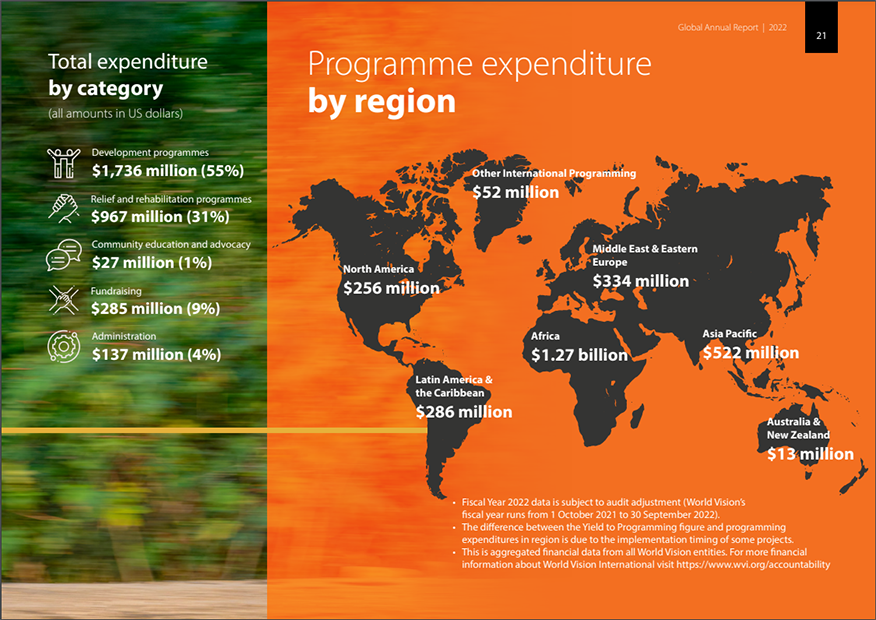
Some highlights of WVI’s annual report include:
- Large photos of smiling beneficiaries—several of which are accompanied by testimonials—to put a face to the impact data featured.
- A strong emphasis on the impact of supporters’ participation in the child sponsorship program.
- Graphs showing the organization’s increase in total revenue over the past six years and a detailed but easily readable summary of annual expenditures.
Read World Vision International’s full annual report.
Smithsonian Institution
The Smithsonian Institution’s mission is to promote “the increase and diffusion of knowledge,” which it does through the 21 museums and one zoo under its control. Because there are so many cultural organizations within this one nonprofit, it produces an extremely comprehensive annual report book each year.
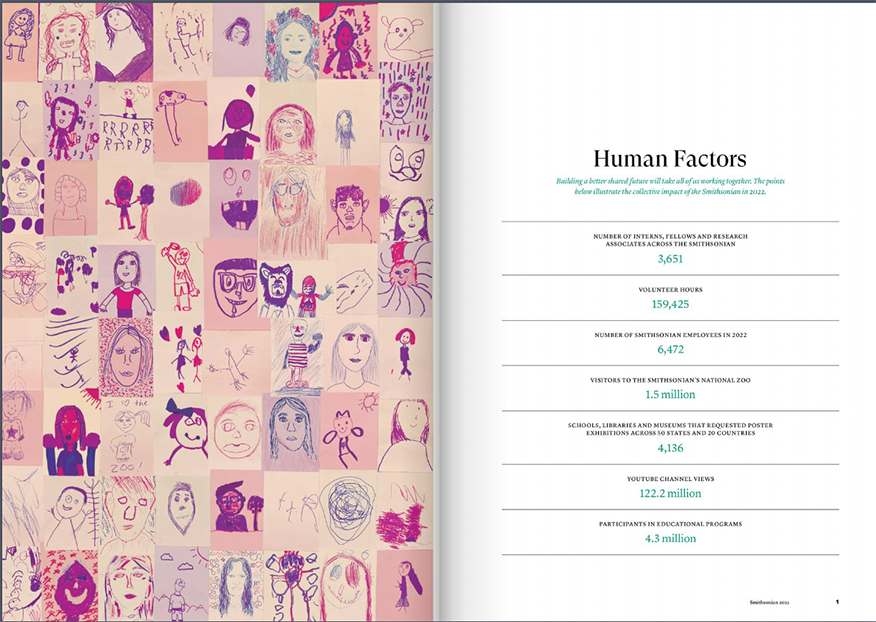
Some highlights of this organization’s 2022 annual report include:
- The statistics in the first spread of the book that highlight the audience’s impact right off the bat.
- First-person perspectives from staff members at many of the Smithsonian’s cultural organizations.
- A thorough and well-organized list of corporate sponsors and major donors.
Read the Smithsonian Institution’s full annual report.
Boston Children’s Hospital
Some large nonprofits, such as higher education or healthcare organizations, may benefit from producing multiple annual reports each year that each focus on one of their areas of work. Boston Children’s Hospital, one of the largest pediatric hospitals in the United States, creates separate reports for each of its individual programs to better highlight the progress and supporters of each one. A few examples include:
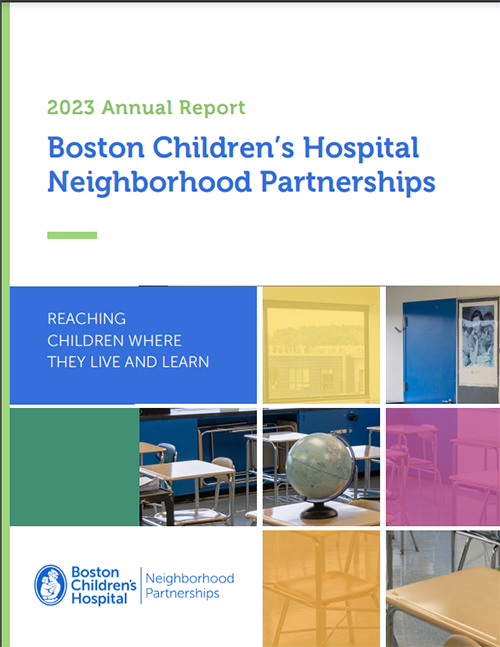
Not only do all of these reports include high-quality data presentations and storytelling, but their visual design appeals to each program’s audience. For example, the Office of Community Health uses a dark color scheme when discussing serious health data, while the bright colors in the Neighborhood Partnerships report give it a welcoming feel. However, all of the reports still feature the Boston Children’s Hospital logo to unify them.
Final Thoughts
An annual report is an effective tool for closing out your nonprofit’s year. It empowers you to highlight your achievements and recognize everyone who has helped you along the way. With the tips and strategies in this guide, you can create an effective annual report that donors look forward to receiving every year.
Remember that annual reports from other nonprofits also provide value to your work. The information within those reports can offer deeper insights that you can use to identify and build relationships with prospective donors.
To learn more about boosting your nonprofit’s fundraising performance, check out these resources:
- Major Gifts: A Guide to Securing Large Donations. Dive deeper into the process of securing major gifts from the donors you’ll feature in the list of major contributors in your annual report.
- Your Annual Fund: A Definitive Guide to Boost Your Strategy. Your nonprofit’s annual fund provides a financial foundation for all of the initiatives you report each year. Discover the best strategies to fill this fund.
- Fundraising Intelligence: Using AI to Enhance Philanthropy. Explore how to leverage AI-powered tools to fundraise and report on your organization’s activities more intelligently.
